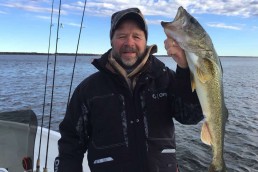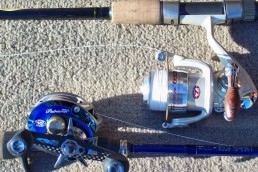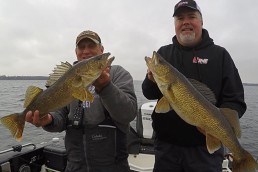I Tried Something Old, and It Still Worked
SHARE THIS POST
Starting last spring, I thought since monofilament fishing line had worked for me in the past, why not give it a try again? Boy, going back to something old really paid off. When I was really big into trout and bluegill fishing in northern Wisconsin, growing up my favorite line was Stren in a 4- or 5-pound-test; it answered my demands of monofilament fishing line. It did not have much memory, casted easily and held up under the tough conditions of snaggy trout streams. It seemed to hold much more than the rated strength, and when hooking a bass or pike while panfishing it brought some big fish to net.
Remember though, back then the only non-stretch line was black Dacron, which I had on my muskie casting rod. The magic FireLine and all the derivatives of this manufacturing process had not even been considered, so, it was mono all the way. And, fish were caught.
Fast-forward to 2017: Fish were caught on mono again, and in fact, in several cases I preferred the “old-school” methods.
While talking with Al Lindner for a Target Walleye/Ice video piece, he said today’s line sales are about even with one-third for the no-stretch lines, one-third for fluorocarbon (invisible to fish the ads say) and one-third for mono. I employed three brands of mono: Northland Bionic Walleye Line, Rapala Sufix and Berkley Trilene XL. I used Sufix in 4-pound-test for panfish and trout. The Bionic (5, 7 pounds) and XL in 6 pounds were ideal for the rigging rods. I rigged for everything, from crappies to shallow walleyes to deep walleyes to smallmouths. When rigging, I discovered that with mono I needed much less tackle. I would estimate the desired leader length, cut and tie in a swivel—with slip sinker and bead between the rod tip and the swivel—attach the leader to the other end of the swivel, add a hook and a bead and then go to work. This worked in early spring for crappies all the way to fall on giant Mille Lacs Lake smallies, but you had to be careful of all the big walleyes that also gobbled up the big chubs.
Probably one thing I learned was not to fish far away from the boat. Keeping the bait near the bottom and often directly under the boat meant that even a delicate pick-up could then be easily detected. With zebra mussels in so many lakes, dragging mono across the bottom leads to frayed line, snags or worse yet, lost fish.
A key to fishing where “zeebs” exist is to use a shorter leader. I never use a leader length of more than 3 feet long under these conditions. One day I started with an 11-foot leader—because that’s how it always used to be—and I was down to 5 feet in short order, and soon settled on the shorter length. Mono is very forgiving, and almost all of this line stretches about 20 percent of its length. One morning I thought I was snagged because the bottom felt really heavy. With steady tension though, I pulled straight up. And after about 4 feet, a head shook its “disapproval” of the plan. It was a 6-pound walleye. With no-stretch line, it would have likely been long gone.
Are you enjoying this post?
You can be among the first to get the latest info on where to go, what to use and how to use it!
Fishing crappies and bluegills was a treat with mono. Accurate pitching/casting to fish in bulrushes was easy, and yanking them out with the 4-pound-test line resulted in only a few break-offs. I strongly urge anglers to net crappies larger than 13 inches. (Release the big mamas to spawn yet another year; keep those 10- or 11-inch fish for eating.)
I love trout fishing, and have experimented with all types of line. Sufix in 4-pound-test really shines when casting spinners or cranks. Big browns and rainbows don’t like hooks, and their acrobatic antics seriously test any line, but when using light line it’s critical to remember that the rod should “match the hatch,” so to speak. I use a 7-foot, medium-light rod with a soft tip. The rod does the work making longer casts possible. By taking line when I can, and back-reeling when I have to, the rod remains at about the same angle. I have landed some very large trout with this combination and tactic.
In streams or rivers, line gets dragged over rocks, around boulders and logs and even snagged on overhanging brush. Abrasion resistance has been built into the three brands I used last year, but that means checking line and re-tying often. To check line for nicks, run it between a wet finger and thumb. If any roughness is felt, clip the line and re-tie.
Just so readers understand, I also use the no-stretch lines and am one of their biggest proponents. For big-river smallmouths on cranks or surface lures I prefer Rapala NanoBraid or Berkley NanoFil, both in 10-pound-test. I also use it when jigging deep weeds or throwing jerkbaits like my favorite lure of all time, the Husky Jerk.
While anglers will continue to use their favorite tactics and gear, I want them to know just how good my “old” monofilament experiment works on many species.
MWO
SHARE THIS POST
Did you enjoy this post?
You can be among the first to get the latest info on where to go, what to use and how to use it!
Jim Kalkofen
Jim Kalkofen grew up with a fishing rod in his hands. After years in the PR game for Mercury and Mepps, he directed the Professional Walleye Trail. He and partners Al and Ron Lindner now provide weekly walleye and ice-fishing education and entertainment in Target Walleye/Ice, a free subscription email (targetwalleye.com). For more info: jim@targetwalleye.com or 651-356-5676.



